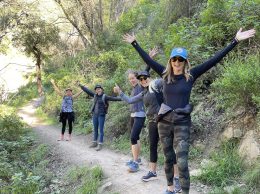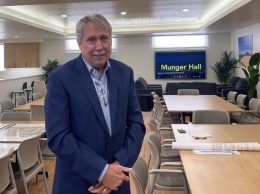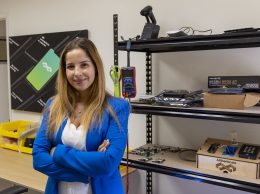Bird-watching apps and electric Porsches: Startups pitch ideas

Patrick Toerner, a student at UC Santa Barbara, pitches his business idea, a bird watching app called Birdeez, to Mark Goldstein. (Stephen Nellis photo)
Spring is startup time at the region’s universities.
At UC Santa Barbara and Cal Poly San Luis Obispo, dozens of student teams are pitching business ideas in hopes of funding, sage mentorship, or at the very least, some free hors d’oeuvres.
Here’s a closer look at two recent campus startup pitch events.
UCSB
UCSB’s Technology Management Program is holding its annual New Venture Competition, where students compete for thousands of dollars in capital and professional services from law and accounting firms. The contest started out with 46 teams and narrowed to 19 for the fair on April 17, where mock investors mingled and heard pitches. The investors, mostly business and technology veterans from the area, allot imaginary capital, and the top six teams move on to a final contest in May.
Chris Bunch and Navraj Chohan, two doctoral students in computer science, are developing AppScale. It lets developers run a version of Google’s App Engine on their own computers. It’s similar to Eucalyptus Systems, the Goleta company whose software lets developers build a private cloud then link it to a public one with Amazon — except that it works with Google’s cloud. The business model is to offer a basic version free but sell an enterprise-class version with support services.
“You can have all of the great things about the cloud, but on your own computer, and move to the cloud when you need to,” said Tyler Krebs, a student involved with the group.
A firm called aPEEL Technologies is being developed by James Rogers and Zubin Kuvadia, who earned doctoral degrees in materials science and chemistry, respectively. They have developed a spray-on substance that could drastically reduce fruit spoilage at packing and shipping houses and are focusing on high-margin crops such as strawberries. “We coat the product with the material to produce a micro-thin film. There’s no pesticides or polymers — it’s completely natural,” Kuvadia said.
For the fashionable crowd, a firm called Threadlings is trying to solve the problem of knowing whether clothes ordered online will fit. The technology asks users for their favorite brands and sizes, and then assembles a store of in-stock items in their size. It reaps a commission when it sends a customer to buy an item. “We’d be more of a Kayak where we’re sending you to Macy’s,” said Mauricio Hernandez. “The goal is to minimize the number of returns.”
Among the more novel ideas was Birdeez, a smartphone and Web app to help bird watchers identify, log and share their sightings. Patrick Toerner, one of the students behind the idea, noted that “birders” often spend fanatically on binoculars and camera gear — and a full-color bird identification book. “That’s what we’re trying to get rid of,” he said.
Eventually the app could use image recognition technology to automatically identify birds and share them on social networks, a boon because birders often have lifetime “lists” of birds they’ve seen and like to compare lists with other birders. “I’m an instant client,” said SoCal IP Law Group attorney Mark Goldstein, who also happens to be a bird watcher.
Cal Poly
The Cal Poly University Center for Innovation and Entrepreneurship held a forum focused on renewable fuels and transportation on April 16, and several teams presented ideas.
One team converted a 1997 Subaru Impreza to run on methanol, also known as wood alcohol because it can be derived from a wide variety of plants. The project involved stripping out nearly every element of the fuel system because methanol corrodes the traditional rubbers used. It cost about $1,300 and took the team of five students about 500 hours to complete.
Nico Lee, the mechanical engineering student who offered up his wheels to serve as the specimen, drove the car from San Luis Obispo to San Francisco and back. It can be tweaked to run on methanol or gasoline or any blend in between — all that is required is plugging in a laptop and making some changes. The team achieved the changes with a blend of mechanical and electronic modifications. “If we put it out as a sort of kit, it would probably be way more electronic,” Lee said. Unfortunately, Lee said the team was told by the California Air Resources Board that it would be infeasible to get the car approved for legal use because of the costs involved.
Another team is hosting an ongoing project involving a 1977 Porsche converted to run on electricity alone. The car was donated by an alumnus, and the team is working to raise money from Central Coast businesses to convert it to lithium batteries to reduce weight and increase speed for a renewable car race in Laguna Seca. “For the engineers, it gives them something to show off. For the business students, it’s great experience building corporate relationships,” Thomas Wilson said.
Another group peddled what it calls a “rapid battery exchanger.” It’s a system where an electric vehicle, say a delivery van, can roll up on a ramp, drop a heavy battery pack and then have another installed. The van can be back on the road in five minutes as the depleted battery pack recharges at the garage.
“The niche it works well with is delivery vehicles or taxis or other vehicles where you own a fleet,” said Scott Spielman. “In the very early 1900s in Paris, they had a taxi system that ran on a battery exchange. Now it’s coming back.”











